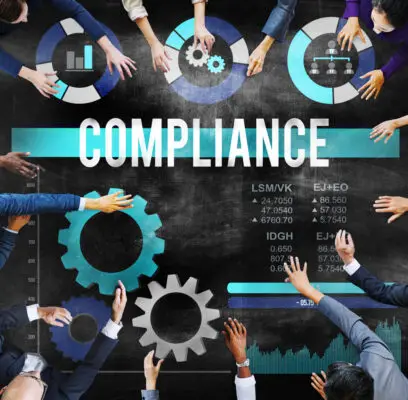A compliance risk assessment questionnaire is a tool used by organizations to identify and evaluate potential compliance risks that may arise within their operations.
This assessment helps organizations understand the level of risk they are exposed to and enables them to develop appropriate strategies to mitigate these risks effectively.
Compliance risk management involves several components, including risk identification, assessment, control implementation, and monitoring.
It is a systematic and comprehensive process that ensures adherence to legal and regulatory requirements, industry standards, and internal policies.
Creating a compliance risk assessment questionnaire involves careful consideration of various factors. This includes determining the scope of the assessment, identifying potential risks, and developing specific questions to gather relevant information.
The questionnaire should be designed to elicit detailed and comprehensive responses to provide a comprehensive understanding of the organization’s compliance risks and other types of risk.
To ensure the effectiveness of a compliance risk assessment questionnaire, it is important to include well-crafted questions that cover a wide range of compliance areas.
These questions should be specific, measurable, and focused on identifying potential risks and control weaknesses. They also need to compare risks emanating from the compliance risk assessment survey.
A compliance risk assessment questionnaire is essential for organizations to proactively manage compliance risks and ensure their operations align with legal and regulatory requirements.

What Is a Compliance Risk Assessment?
A compliance risk assessment is a systematic process used by organizations to identify, assess, and manage potential risks related to non-compliance with laws, regulations, and internal policies, ultimately aiming to ensure regulatory adherence and prevent financial and reputational damages.
This process often involves using a compliance risk assessment questionnaire to gather information about the organization’s compliance practices, controls, and procedures.
The questionnaire may cover various areas, including industry standards, internal documents, compliance audits, and compliance assessments.
The information collected through the questionnaire is then analyzed and evaluated to identify potential areas of non-compliance and regulatory risk. Various categories of compliance risk need to be captured through a risk register.
Senior management plays a crucial role in the compliance risk assessment process, as they oversee developing and implementing a compliance risk management plan.
Organizations can proactively address potential compliance issues and mitigate non-compliance risks by conducting regular compliance risk assessments.
What Are the Components of Compliance Risk Management?
The components of compliance risk management encompass various aspects of organizational control and governance.
One important component is the residual risk rating, which evaluates the level of risk that remains after controls are in place. This rating helps organizations prioritize their efforts to mitigate risks.
Another component is the risk and compliance self-assessment questionnaire, which allows organizations to gather information about their compliance risks from different departments and individuals. This questionnaire helps identify areas of non-compliance and potential vulnerabilities.
Additionally, compliance risk management involves identifying applicable risk owners responsible for managing and mitigating specific organisational risks.
It also includes categorizing compliance risks into different types, such as legal, financial, or operational risks, to understand better and address them.
Comparisons among risks and the use of compliance risk assessment templates further enhance the effectiveness of compliance risk management.
Steps to Create a Compliance Risk Assessment Questionaire
The first step is to set objectives, which involves defining the purpose and scope of the assessment. This helps ensure that the questionnaire is focused and tailored to the specific compliance risks of the organization.
The second step is to prepare, which includes gathering relevant information and resources, identifying key stakeholders, and establishing a timeline for the assessment.
Finally, the third step is to conduct the risk assessment, which involves designing the questionnaire, administering it to relevant individuals, and analyzing the responses to identify and assess compliance risks.
Step 1: Set Objectives
To effectively conduct a compliance risk assessment, it is crucial to establish clear objectives. These objectives guide the entire process and ensure the risk assessment efforts are focused and aligned with the organization’s goals.
Setting objectives involves defining the purpose of the compliance risk assessment questionnaire and determining what specific risks will be assessed.
The risk assessment director or team should consider various factors, such as the organization’s industry, regulatory requirements, and business operations, to identify the relevant risk domains.
Additionally, the objectives should specify the desired outcomes of the risk assessment, such as identifying and prioritizing risks, assessing the effectiveness of controls, and providing recommendations for risk mitigation.
Setting clear objectives, the risk assessment framework and methodology can be tailored to address these specific objectives, ensuring a comprehensive and meaningful assessment of compliance risks.
| Objective | Description |
|---|---|
| Identify risks | Determine potential compliance risks within the organization |
| Prioritize risks | Evaluate the effectiveness of existing controls in managing identified risks. |
| Assess controls | Evaluate the effectiveness of existing controls in managing identified risks |
Organizations can gain valuable insights into their compliance risk landscape and make informed decisions on risk mitigation strategies by employing a systematic approach to risk identification and incorporating these objectives into the compliance risk assessment questionnaire.

Step 2: Make Preparations
The second step in preparing for a compliance risk assessment questionnaire involves assembling a team, developing a framework and methodology, designing a data repository, and deciding on an implementation plan and timeline.
Assembling a team involves selecting individuals with the necessary knowledge and expertise in compliance and risk management.
Developing a framework and methodology ensures that the assessment is conducted in a structured and consistent manner while designing a data repository allows for the efficient storage and management of assessment data.
Finally, deciding on an implementation plan and timeline enables the successful execution of the compliance risk assessment process.
Assemble a Team
Assembling a team for the compliance risk assessment process is crucial in order to ensure a comprehensive and unbiased evaluation of potential risks, thereby instilling confidence in the organization’s ability to comply with regulatory requirements.
To effectively assemble a team for compliance risk assessment, consider the following key factors:
1. Expertise: Select individuals with a deep understanding of compliance risk management activities and experience in risk analysis.
2. Diversity: Include representatives from different departments to gather diverse perspectives and knowledge.
3. Collaboration: Encourage team members to collaborate and share information to conduct regular risk assessments.
4. Training: Provide training on formal risk management procedures and strategies and using powerful risk management tools.
Develop a Framework and Methodology
One important step in the compliance risk assessment process involves developing a framework and methodology that outlines the systematic approach to evaluating and mitigating potential risks.
This framework should consider the compliance risk management programs and the compliance risk landscape.
It should include decisions about risk mitigation, such as determining the inherent risk likelihood and inherent risk rating, as well as providing comprehensive compliance risk management recommendations and a risk mitigation strategy for each phase of the risk assessment process.
Design a Data Repository
Designing a data repository involves creating a structured and organized system for storing and managing data related to compliance risk assessment, ensuring easy access and retrieval of information for analysis and decision-making purposes.
This involves incorporating risk management tools such as risk heat maps, matrices, and prioritization techniques.
The data repository should capture various risk factors, risk events, risk exposures, and risk postures to assess compliance risks effectively.
A comprehensive risk assessment questionnaire should also be included to gather relevant information.
Decide on an Implementation Plan and Timeline
To establish a robust and efficient data repository, it is essential to develop a well-defined implementation plan and timeline that outlines the necessary steps and milestones for successful deployment.
The implementation plan should include tasks such as:
– Identifying the key stakeholders
– Allocating resources
– Establishing a communication plan.
Additionally, a timeline should be created to ensure that the necessary activities are completed within the specified timeframes.
This will help to ensure the successful implementation of the compliance risk assessment questionnaire.
Step 3: Conduct the Risk Assessment
Conducting the risk assessment involves evaluating potential compliance risks and identifying any areas of vulnerability within the organization’s operations.
Compliance risk management is crucial for organizations to ensure adherence to regulatory requirements and avoid legal and financial consequences.
Organizations can utilize various risk management tools such as checklists, sample questions, and interview questions to conduct a comprehensive risk assessment.
These tools help identify priority risks and assess residual risk likelihood.
The risk assessment process may involve using a library of question types, including multiple-choice questions, to gather relevant information.
Additionally, organizations should ensure that the completion of training is documented to demonstrate compliance efforts.
Organizations can proactively identify and address potential compliance risks by conducting a thorough risk assessment, minimizing the likelihood of non-compliance incidents.
Best Compliance Risk Assessment Questionaire Questions
One crucial aspect of a compliance risk assessment questionnaire involves formulating effective questions that can accurately identify potential compliance risks within an organization.
To ensure a comprehensive assessment, it is important to incorporate various questions covering different aspects of compliance risk management.
Some key questions to consider include:
1. Open-ended feedback questions allow employees to provide detailed insights about potential compliance risks they have observed or experienced.
2. Job training and verification: Questions about the adequacy of job training and the verification of training completion can help identify employee knowledge and skills gaps.
3. Departmental training and policy description: Assessing the quality and clarity of departmental training programs and the description of compliance policies can help identify areas where improvements are needed.
Examples of Questions Include:
- Does your organization have a designated compliance officer or compliance committee?
- Are written policies and procedures in place to ensure compliance with laws, regulations, and standards?
- How often are compliance training and education provided to employees?
- Are there mechanisms to enforce compliance policies and procedures (e.g., disciplinary measures)?
- How does the organization identify, assess, and manage compliance risks?
- Are there procedures in place for reporting compliance issues or concerns? Is there a confidential or anonymous reporting mechanism (e.g., a hotline)?
- How does the organization respond to compliance issues when they are identified? Is there a process for investigating and resolving these issues?
- Does the organization regularly review and update its compliance program to address changes in laws, regulations, and standards?
- Are there procedures to monitor and audit compliance with policies and procedures?
- How does the organization ensure that business partners, vendors, and contractors are in compliance with relevant laws, regulations, and standards?
- Does the organization have a disaster recovery plan to ensure business continuity during a disruption?
- How does the organization ensure data privacy and security compliance?
- Does the organization have a process for managing and mitigating conflicts of interest?
- How does the organization ensure compliance with anti-bribery and anti-corruption laws?
- Does the organization have a process for managing and mitigating financial risks?
Including these questions in the compliance risk assessment questionnaire, organizations, especially midsize organizations, can obtain valuable insights to enhance their compliance risk management efforts.
Effective compliance risk management is crucial for organizations to ensure they meet regulatory requirements and minimize potential risks. It involves evaluating various types of risks and categorizing them accordingly. By comparing these risks, organizations can better understand their compliance risk profile.
Organizations may use surveys or questionnaires to gather information to conduct an effective compliance risk assessment. These assessments help identify any existing third-party risks and assess the adequacy of the organization’s risk management program.
By adopting a holistic approach to risk assessment, organizations can address all phases of risk evaluation and identify areas of residual risk likelihood.
The findings of a risk assessment provide valuable insights into an organization’s risk profile and enable the development of mitigation recommendations.
It is essential to ask the right questions during the assessment process. This may include a checklist of sample questions and open-ended, text-type questions that allow for more detailed responses.
Training plays a crucial role in compliance risk management. Organizations should ensure that completion of training is documented and that it is mandatory for employees.
This can be achieved through various training methods, such as one-on-one sessions, departmental training, or unit-specific training. By aligning training with company policies and industry regulations, organizations can create a secure environment and reduce the pressure they face.
Compliance risk assessment also involves evaluating operational controls and conducting control assessments.
Organizations can refer to resources like the Export Control Office’s achievable steps and industry gold standard questionnaires to ensure they follow best practices.
Partner data management practices and data privacy questionnaires can also be used to assess compliance with federal regulations and industry standards.
Effective compliance risk management requires a comprehensive risk assessment and mitigation approach. By conducting thorough evaluations, organizations can identify potential risks, make informed decisions, and ensure compliance with legal requirements.
It is crucial for organizations to prioritize risk management and take proactive steps to protect their reputation and avoid potential legal consequences.
Frequently Asked Questions
What are the common challenges organizations face in conducting compliance risk assessments?
Organizations’ Common challenges in conducting compliance risk assessments include lack of resources, inadequate expertise, complex regulatory requirements, insufficient data, and difficulty assessing controls’ effectiveness and mitigating risks.
How often should a compliance risk assessment questionnaire be updated?
Compliance risk assessment questionnaires should be regularly updated to ensure their effectiveness.
The frequency of updates should be determined by factors such as regulatory changes, organizational changes, and the level of risk associated with the compliance requirements.
What role does technology play in streamlining compliance risk assessment processes?
Technology is crucial in streamlining compliance risk assessment processes by automating data collection and analysis, enhancing efficiency, accuracy, and consistency, and facilitating real-time monitoring and reporting, thereby reducing human error and saving time and resources.
Are there any industry-specific guidelines or regulations to consider when designing a compliance risk assessment questionnaire?
When designing a compliance risk assessment questionnaire, industry-specific guidelines and regulations must be considered.
These guidelines ensure the questionnaire addresses the industry’s risks and requirements, enhancing the assessment process’s effectiveness and relevance.
How can organizations ensure the information collected through a compliance risk assessment questionnaire is accurate and reliable?
Organizations can ensure the accuracy and reliability of information collected through a compliance risk assessment questionnaire by implementing robust validation processes, conducting regular audits, utilizing independent third-party assessments, and employing data verification techniques.

Conclusion
A compliance risk assessment is essential for organizations to identify, evaluate, and mitigate potential compliance risks. It involves assessing various components such as legal and regulatory requirements, internal policies and procedures, and the effectiveness of control measures.
Organizations can gather valuable information to make informed decisions and develop effective risk management strategies by conducting a comprehensive compliance risk assessment questionnaire.
The questionnaire should include well-crafted questions that cover all relevant areas of compliance risk, ensuring a thorough and analytical approach to risk assessment.

Chris Ekai is a Risk Management expert with over 10 years of experience in the field. He has a Master’s(MSc) degree in Risk Management from University of Portsmouth and is a CPA and Finance professional. He currently works as a Content Manager at Risk Publishing, writing about Enterprise Risk Management, Business Continuity Management and Project Management.


